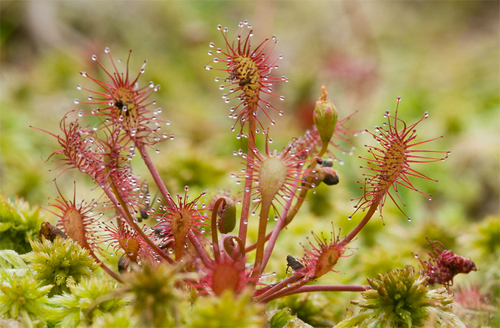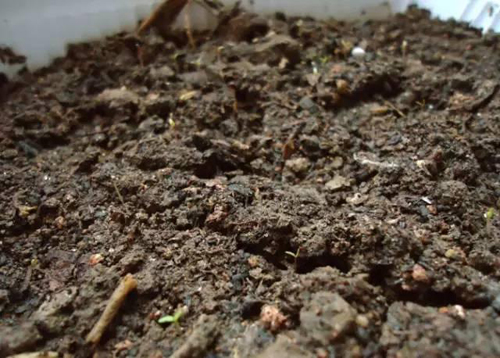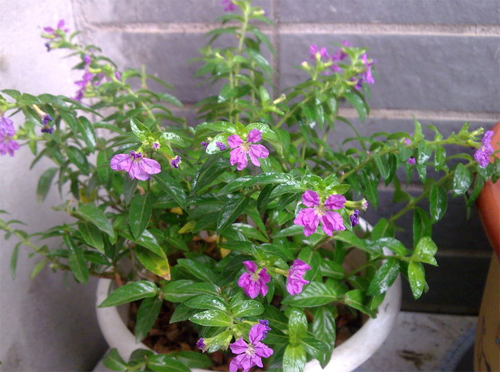How do you grow these varieties of sunflowers?
Thatched vegetable is very good-looking, there are small tentacles on the leaves, it is so magical, but also to open meat, to eat insects, thatched vegetable and man-eating grass look like, how to raise thatched vegetable? What varieties do you have?

How to raise thatched vegetables:
1. Soil:
In addition to bulbous thatch vegetables, other kinds of thatch vegetables do not have high requirements for soil, can use pure water moss, can also use two parts of water moss and peat mixed with perlite, and have also added a portion of red jade soil, bark, vermiculite and other substrates. Bulbous grass extract can use granular soil, such as basin immersion culture can use 1 part of peat, 1 part of perlite or river sand mixture.
2. Lighting:
Thatched vegetables like plenty of sunlight, exposure resistance, suitable for placed on a well-lit balcony or window, if it can provide direct light throughout the day, it will show a very bright color, and the mucus will become thicker.
If there is no good lighting environment, bright scattered light should be provided throughout the day.
3. Humidity:
The humidity requirement of thatched vegetable is not high, and it needs to be controlled at 40% Mur90%. The higher humidity can make the "dewdrop" of glandular hair bigger and more ornamental. When the air humidity is not high in the plum rain season, attention should be paid to strengthening ventilation, which may cause the stems and leaves of thatched vegetables to rot.
4. Watering:
Thatched vegetables are usually more resistant to moisture, and the soaking basin method can be used for water supply, that is, flowerpots are placed in containers such as water plates and glass vats, so that the water can infiltrate into the whole flowerpot by itself, as long as there is about 1 cm of water in the water plate. to keep the matrix moist.
Mao paste vegetables have high requirements for water quality, and soft water with low content of calcium, magnesium and other minerals should be used when watering.
5. Fertilization:
In the growing season, it is necessary to use general compound fertilizer to dilute 5000 times and spray foliage 1-2 times a month.
Fertilization would rather be applied frequently with thin fertilizer, not too high concentration, so as to avoid serious consequences of fat injury or even death.
Do not apply fertilizer at will if you have no experience. Feeding is not recommended to provide nutrients so as not to affect the ornamental quality.
6. Diseases and insect pests:
In spring and summer every year, the new buds of Castanopsis thunbergii may be attacked by aphids, resulting in abnormal leaf growth or wilt.
When green insects, ground tigers and other pests are likely to gnaw on the leaves of thatched vegetables, when the leaves are found to have been eaten, they should be caught and killed in time, or broad-spectrum (general-purpose) pesticides can be used to kill them, and wet the leaves when using them. Do not spray too much.
Varieties of thatched vegetables:
1. Nest-shaped grass extract vegetables
The nest-shaped thatch vegetable originates in the remote mountains of South Africa, where the climate is stable all the year round and does not exceed 33 degrees in summer. In cultivation, nest-shaped and Cape of good Hope are the first choice for upright thatch ointment, but nesting-shaped thatch ointment is more delicate and should be afraid of heat, so it is suitable for cultivation with breathable medium.
2. Cape of good Hope
This is the most famous thatched vegetable, the tall and powerful image is deeply rooted in the hearts of the people, the leaves are very exaggerated, in the origin of South Africa is a lowland thatch vegetable, with a number of individuals, a bit afraid of heat in cultivation, ventilation and shade farming in summer, autumn will be very beautiful.
3. Silk leaf thatch extract vegetable
Silk leaf grass extract can be roughly divided into red silk leaf, green silk leaf, common silk leaf, of which red silk leaf is the most famous variety. In the cultivation of a little afraid of heat, summer to avoid the noon shade, but also regarded as an entry-level variety of temperate thatched vegetables, worth collecting.
Other varieties of thatch ointment include Belle thatch extract, forked leaf thatch ointment, Afinis thatch ointment, Haberidi ointment, Alice thatch ointment, peacock thatch ointment, imperial thatch ointment, Bermanimo ointment and so on.
This is the end of the cultivation and variety introduction of thatched vegetable. Friends who like this kind of furry plant, raise it quickly.
How to raise thatched vegetable
Thatched vegetable is a variety of insectivorous plants, many flower friends do not know how to raise thatched vegetable, this paper is a summary of the experience of raising thatched vegetable, first of all, talk about the varieties of insectivorous plants, mainly flycatcher, thatched vegetable, bottle grass, pansy, raccoon algae, soil bottle, sun bottle grass, rainbow grass, style grass and so on.
All insectivorous plants can not be planted with nutritious soil or ordinary garden soil, but should be planted with substrates such as peat perlite or water moss, while the water should be grown with low mineral water (Rain Water, pure water, air-conditioned water, etc.). Some of them are mini grass. Let's introduce the vegetable.
Thatched vegetables like to be wet among insectivorous plants, and they have to be soaked in pots all the time except for other seasons in winter. Another factor for raising good herbaceous vegetables is light. Many people's insectivorous plants generally say that they are not red or grow weak. A large part of the reason is that they do not dare to bask in the sun. In fact, thatched vegetables are very light-hungry. In addition, many people think that the dewdrops of thatched vegetables are stuffy. So it has been kept stuffy all the time, but once the dewdrops are removed from the bag, it will be gone. In fact, this is not the case. The dewdrops of Castanopsis thunbergii are mainly produced by photosynthesis and have little to do with air humidity, so if the light is good, the dewdrops will be big.
There are many varieties, and different planting methods are needed according to different varieties, including summer dormancy (various Cape of good Hope, bulb root ointment, etc.), winter dormancy (silk leaf ointment, Belle thatch ointment, forked leaf thatch ointment, etc.), cold-resistant (Northern Territory), and a unique kind: mini thatch ointment (adult plant is very small and lovely)
There are four kinds of Cape of good Hope, mineral red, white, broad leaves and full red, among which the White Cape of good Hope is the most afraid of heat, and the all-Red Cape of good Hope is the most heat-resistant. Cape of good Hope will dormancy above 30 degrees in summer, mainly because the new leaves begin to turn yellow. then stop growing, if the temperature is too high, all leaves may wither, from the discovery that the Cape of good Hope is about to dormancy, we should try our best to avoid direct sunlight after 9 o'clock and slowly control moisture. Stop soaking the basin and keep the substrate slightly moist until it is cool in autumn, the Cape of good Hope will sprout again (there are also those that cannot grow, mainly depending on the size of the plant before summer treatment and dormancy, and it is too small to sprout again in autumn. I feel that the autumn recovery of the Cape of good Hope is equivalent to the root cutting of thatched vegetables).
You can stop soaking the basin in winter when you are dormant in winter and keep the matrix dry. These thatch vegetables are relatively hardy, generally minus 5 degrees is no problem. Students from Jiangsu, Zhejiang and Shanghai will be put outdoors in winter and will not freeze to death. In other seasons, as long as soaking the basin to increase the sun can grow very well.
The Northern Territory is very heat-resistant, can withstand the high temperature of more than 40 degrees, the higher the temperature, the stronger the sun, the better, mainly afraid of the cold, winter below 10 degrees need to be heated, there are two main types (wetland species and dry land species).
The culture method of wetland species is the same as that of common thatched vegetables, as long as soaking pots to increase the sun, while dryland species are afraid of hot summer to control moisture and keep the substrate ventilated or else it is easy to rot roots, so wetlands are good for raising dryland and difficult to maintain. The way to distinguish between wetlands and dryland is to look at the shape of winter buds (winter buds are a unique breeding method of miniature grass, produced by short-day exposure and low temperature stimulation, and the metamorphosis of leaves is equivalent to seeds, with a germination rate of almost 100%). The winter buds of wetland species are flaky and those of dryland species are granular.
To sum up, the main way to raise beautiful thatch vegetables is to soak in the basin and add sun exposure (proper shade in summer and exposure in the northern territory). Except for the Northern Territory and some annual varieties (Jindilo), other varieties are basically hardy. Jiangsu, Zhejiang and Shanghai are basically able to survive the winter outdoors, the above is purely personal experience, for reference only.
How to raise Maogao vegetable the culture method of Maogao vegetable
The leaves of Castanopsis grossedentata are covered with crystal-clear "dewdrops", which are dazzling and deeply loved by people. So, how to raise thatched vegetables? Today, the editor is here to teach you the breeding method of maojingcai. If you are curious, come and have a look with the editor.
First, how to raise thatched vegetables?
1. Soil: in addition to bulbous thatched vegetables, other kinds of thatched vegetables do not have high requirements for soil, can use pure water moss, can also use two portions of water moss and peat mixed with perlite, and have added a matrix such as red jade soil, bark, vermiculite and so on. Bulbous grass extract can use granular soil, such as basin immersion culture can use 1 part of peat, 1 part of perlite or river sand mixture.
two。 Lighting: thatched vegetables like plenty of sunlight, exposure resistance, suitable for placed on the balcony or window with good light, if it can provide direct light throughout the day, it will show a very bright color, and the mucus will become more sticky. If there is no good lighting environment, bright scattered light should be provided throughout the day.
3. Humidity: Mao paste vegetables do not have high requirements for humidity, which needs to be controlled at 40%, 90%. Higher humidity can make the "dewdrops" of glandular hairs bigger and more ornamental. When the air humidity is not high in the plum rain season, attention should be paid to strengthening ventilation, which may cause the stems and leaves of thatched vegetables to rot.
4. Watering: Mao paste vegetables are usually more resistant to moisture, and the soaking pot method can be used for water supply, that is, flowerpots are placed in containers with water, such as water plates and glass vats, so that the water can infiltrate into the whole flowerpot by itself, as long as there is about 1 cm of water in the water plate. to keep the matrix moist. Mao paste vegetables have high requirements for water quality, and soft water with low content of calcium, magnesium and other minerals should be used when watering.
5. Fertilization: in the growing season, it is necessary to use general compound fertilizer and other diluted 5000 times to spray foliar, 1-2 times a month. Fertilization would rather be applied with thin fertilizer frequently, not too high concentration, so as to avoid serious consequences of fat injury or even death. Do not apply fertilizer at will without experience. Feeding is not recommended to provide nutrients so as not to affect the ornamental quality.
6. Diseases and insect pests: in spring and summer every year, the new buds of Castanopsis thunbergii may be attacked by aphids, causing abnormal growth or wilting of leaves. When green insects, ground tigers and other pests are likely to gnaw on the leaves of thatched vegetables, when the leaves are found to have been eaten, they should be caught and killed in time, or broad-spectrum (general-purpose) pesticides can be used to kill them, and wet the leaves when using them. Do not spray too much.
2. Varieties of Castanea mollissima
1. Nest-shaped thatched vegetable
The nest-shaped thatch vegetable originates in the remote mountains of South Africa, where the climate is stable all the year round and does not exceed 33 degrees in summer. In cultivation, nest-shaped and Cape of good Hope are the first choice for upright thatch ointment, but nesting-shaped thatch ointment is more delicate and should be afraid of heat, so it is suitable for cultivation with breathable medium.
two。 Cape of good Hope
This is the most famous thatched vegetable, the tall and powerful image is deeply rooted in the hearts of the people, the leaves are very exaggerated, in the origin of South Africa is a lowland thatch vegetable, with a number of individuals, a bit afraid of heat in cultivation, ventilation and shade farming in summer, autumn will be very beautiful.
3. Silk leaf thatch extract vegetable
Silk leaf grass extract can be roughly divided into red silk leaf, green silk leaf, common silk leaf, of which red silk leaf is the most famous variety. In the cultivation of a little afraid of heat, summer to avoid the noon shade, but also regarded as an entry-level variety of temperate thatched vegetables, worth collecting.
Other varieties of thatch ointment include Belle thatch extract, forked leaf thatch ointment, Afinis thatch ointment, Haberidi ointment, Alice thatch ointment, peacock thatch ointment, imperial thatch ointment, Bermanimo ointment and so on.
The above is the Xiaobian introduced to you how to raise thatched vegetable, the content of the breeding method of thatched vegetable, you are interested to share it with your friends!
- Prev

What is the price of sunflower seed planting method?
Sunflower is not what we often call sunflower, sunflower is also called pine leaf peony and can't die. What is the planting method of sunflower seed? What is the price of sunflower seeds? Sunflower seed planting method: prepare the soil, after Ching Ming Festival (the temperature of 20 degrees is the most suitable
- Next

How to raise common diseases and prices of calyx flowers
Calyx flowers grow like stars in the sky, but the flowers are much bigger than stars in the sky. Most of them are red, and most of them change color. How to raise the calyx from the flower? What are the common diseases? How much is the price? How to raise the calyx from the flower? Soil selection, Calyx flower is suitable for growing in sandy soil.
Related
- Fuxing push coffee new agricultural production and marketing class: lack of small-scale processing plants
- Jujube rice field leisure farm deep ploughing Yilan for five years to create a space for organic food and play
- Nongyu Farm-A trial of organic papaya for brave women with advanced technology
- Four points for attention in the prevention and control of diseases and insect pests of edible fungi
- How to add nutrient solution to Edible Fungi
- Is there any good way to control edible fungus mites?
- Open Inoculation Technology of Edible Fungi
- Is there any clever way to use fertilizer for edible fungus in winter?
- What agents are used to kill the pathogens of edible fungi in the mushroom shed?
- Rapid drying of Edible Fungi

